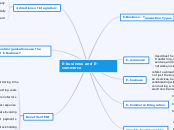E-business and E-commerce
E-Business – Transaction Types
Business-to-business (B2B)
Collaborative Commerce (C-Commerce)
Business-to-Consumers (B2C)
Consumers-to-Businesses (C2B)
Consumer-to-Consumer (C2C)
Intra-business (Intra-organizational) Commerce
Government-to-Citizens (G2C)
Mobile Commerce (M-Commerce)
E-commerce
describes the process of buying, selling, transferring, or exchanging products, services, and/or information via computer networks, including the Internet
E-business
refers to a broader definition of e-commerce, not just the buying and selling of goods and services, but also servicing customers, collaborating with business partners, conducting e-learning, and processing electronic transactions
E-Commerce Integration
Vertical integration
Cross-business integration
Integration of technology
Aim of E-buz Integration
Aimed at cost savings,
Improvements in efficiency,
Productivity.
4 directions of integration:
Vertically
Laterally
Horizontally
Downward
Why should organisations use the Internet in Business?
Access to a global market;
Potential for widening consumer choice;
Ease with which a business can interact with and solve customer problems
Potential cost savings;
Transaction ease and convenience
Opportunities for close alliances with stakeholders (suppliers, clients,....)
Benefits of EDI
Shortened ordering time
Cutting costs
Elimination of errors
Fast response
Accurate invoicing
EDI payments
Reduced stock holding
Accelerated Cash flow
Business opportunities
Customer lock-in
